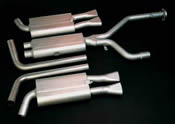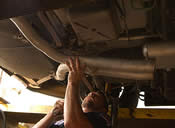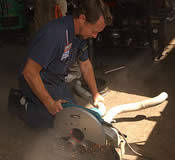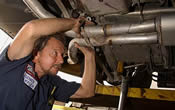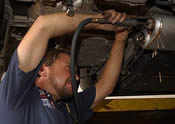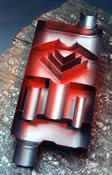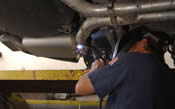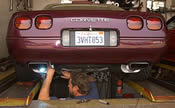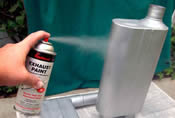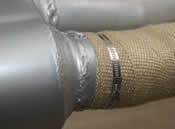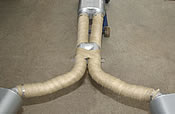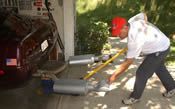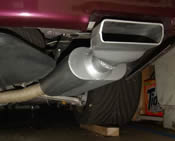1992 - 1996 Corvette: Tech Article: Quietly Powerful: How to Build a C4 LT1/4/5 Exhaust that Gains 28 hp and...is Quiet
Estimated Reading Time: 12 MinutesQuietly Powerful: How to Build a C4 LT1/4/5 Exhaust that Gains 28 hp and...is Quiet
Text and Images by Hib Halverson
©2003 Shark Communications
No Use Without Permission
Next to changing wheels, I think exhaust systems are the most popular aftermarket modification done by most Corvette owners. We do this to get more performance, different sound, more attractive appearance or, all three. Exhaust choices are very subjective. Some like multiple chrome tips. Others like two, big, black outlets. Some insist on stainless steel construction. Some don’t care what metal is used. Some like really loud exhaust. Others like quiet.
Personally, I like an exhaust which is powerful but quiet. I don’t need to announce my car is coming but I do need to arrive and depart quickly.
Many years ago, I settled in Flowmaster exhaust products as those I like best. They are a great value, they always offer a noticeable increase in performance and you get that classic "Flowmaster Sound" which has pleased many a hot rodder over the years. I have Flowmaster exhausts on all my cars. One of them is a C4, a 1995 ZR-1, to be exact. The first performance enhancement I added to the car right after I bought it was the Flowmaster cat-back for ’90-’95 ZR-1s (PN 17115). This system is generally the same as the Flowmaster system for ’92-’96 LT1/LT4 (PN 17217) cars except for the locations of the connections to the engine. This modification worked well--I saw a 12hp gain on a DynoJet chassis dyno and I got that Flowmaster sound I like so much. The fact that, with a stock engine, the Flowmaster cat-back exhaust can make 8-12 hp more more the production exhaust which has quarter-inch larger pipes says a lot about the restriction in the stock C4 exhaust.
As the years went by, I continued to modify my car and the engine’s power began to approach the 475 hp mark (my goal was 500 hp using stock exhaust manifolds and cats); I began to wonder if my exhaust was adequate. Three parts of the standard Flowmaster cat-back system might cause some restriction when used on a 500 hp engine: the connection at the front of the resonator, the somewhat small, 2.5-in pipe diameter (stock pipes on a ZR-1 is 2.75-in.) and the somewhat small volume inside each muffler.
The solution to this was to design my own system and have a good exhaust fabrication shop build it using other Flowmaster products. I decided to crossbreed a stock ’96 Grand Sport’s exhaust (for its 2.75-in pipes and rear crossover), a Flowmaster 2-into-1, ’Y-Collector’, the resonator out of my existing Flowmaster system and a set of larger, Flowmaster 50-series Delta-Flow mufflers . My goal was another 10 hp above what I got from the Flowmaster cat-back.
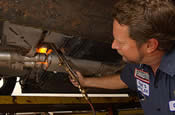 |
|
Click image for larger view
Greg Coats first act was to break-out the ’flaming hack saw’ (acetylene torch) and cut the Flowmaster cat-back exhaust off behind the resonator. Image: Author |
The first step in this development program was to dyno test the car with the stock exhaust back in place. On the chassis dynamometer, a DynoJet 248H which I used for all of the development and testing, the car made 362, SAE-corrected horsepower at the rear wheels. I then removed the stock exhaust, reinstalled the standard Flowmaster cat-back and ran the car on the DynoJet, again. This time, the car made 380, SAE horsepower at the rear wheels, an 18 hp increase! Clearly, the stock ZR-1 exhaust is a big restriction and the Flowmaster exhaust system is an outstanding improvement. The question was: will a further reduction in restriction pay-off in an additional, practical power increase?
Gene’s Mufflers in Downey, California does all my exhaust work. Actually, the shop doesn’t have a ’Gene’ and is owned by ace exhaust fabricator, Greg Coats. I’ve been testing exhaust components for a long time and I’ve learned there is a big difference between an ordinary muffler shop and a true exhaust fabricator. The differences are the experience, skill and intelligence of those doing the work and a little of having the right tools, particularly a wire-fed arc welder and a tubing bender capable of accepting three-inch pipe. Gene’s Mufflers is that kind of place.
The first thing Greg did was cut the head pipes off the stock resonator and the outlets off the back of the stock mufflers then scrap what was left. Coats then turned his attention to the standard Flowmaster cat-back on the car, He cut the system just behind the resonator and scraped that piece. Then, he removed the resonator and head pipe assembly, cut the head pipes off right at the resonator, scrapped the pipes and set the resonator on the work bench.
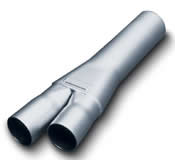 |
|
Click image for larger view
The Flowmaster Y-Collector. Image: NA |
Greg Coats reformed the outlet of the Flowmaster Y-Collector (PN 3004000) into an oval, shortened the collector, then installed it in place of the original inlet on the Flowmaster resonator. From a fabrication standpoint, this task was one of the most difficult and time-consuming of the project, requiring some planning and significant welding skills. We mocked-up the modified resonator in the same location it occupied before, cut the ends of the stock head-pipes to the right length, reinstalled the stock head pipes, then welded the modified Flowmaster resonator in place. Next, Greg hoisted the rear section from a ’96 Grand Sport, manual trans. exhaust (which I’d purchased from a GS owners upgrading his exhaust) in place for a test fit. He cut the pipe ends at the proper angles and lengths then welded the GS rear section to the Flowmaster resonator. Once these pieces were in place, we reused the stock exhaust hangers at the rear of the transmission and ahead of the rear axle. This was done to simplify removal and replacement of the system and to preserve the OE exhaust’s noise and vibration isolation features.
The Flowmaster 50-Series Delta-Flow muffler is intended for use on engines that put out a large volume of exhaust gases at a high flow rate. They are a three-chamber muffler with a case that is 17x9.75x4-inches, considerably larger than the mufflers of a standard Flowmaster cat-back. A 50-Series Delta-Flow is different from a standard Flowmaster 50-Series unit in that its rear chamber contains multiple, V- or ’delta’-shaped deflectors (as opposed to the single deflector in non-Delta-Flow units) which split, then reform exhaust flow in a manner that has phase shifts reducing acoustic energy. Generally, Delta-Flow mufflers have the same flow numbers as the equivalent non-Delta-Flow muffler but are quieter. The particular 50-Series Delta-Flows we used (PN 843051) have three-inch connections with the inlet offset and the outlet centered.
Greg Coats cut the mounting brackets off the Flowmaster cat-back mufflers than welded them to the 50-series Delta-Flows. This enabled us to use the stock, rubber-isolated, C4 muffler hangers. He, then, welded the new mufflers in place. A lesser-skilled muffler shop may insist that a muffler as large as the Flowmaster 50-series will not fit under the back of a C4 with a spare tire carrier, however, a skillful exhaust service shop, such as Gene’s Mufflers, gets the job done by carefully tilting and turning the muffler until it fits in the space, then doing the right pipe bending and welding to get the Flowmasters to connect to the Grand Sport rear pipes. The last complex fabrication work was to modify the stock, ’92-’96 exhaust tips then attach them to the Flowmaster mufflers.
With my new exhaust installed, I bid farewell to Greg Coats and the guys at Gene’s and returned to my own shop for some paint work. The Flowmaster 50-Series mufflers are made of 409 stainless steel but they are manufactured with standard welding wire which rusts. The solution is to paint the mufflers with Eastwood Silver Exhaust Paint (PN 10020Z). In a decade of using Eastwood Exhaust Paint, I have found that product to be the best on the market for painting exhausts parts that see sustained temperatures below 400 deg. F. Generally, this means anything except exhaust manifolds, headers or catalytic converters. In my experience, when painted with Eastwood Exhaust Paint, parts on cars driven in areas that do not see a lot of severe weather need to be repainted only about every three years. That’s good durability which I’ve not see with any other silver paint.
To reduce the amount of heat radiated from the exhaust system to the floor and then into interior, I applied Thermo-Tec Exhaust Insulating Wrap (PN 11001) to the pipes between the cats and the resonator and those between the resonator and the mufflers. Thermo-Tec originated the exhaust wrap product and, while there are less expensive imitators on the market, I have found Thermo-Tec to be the best choice in exhaust wraps. It quite effective in keeping heat in the exhaust and out of the interior and, provided you don’t scrape the exhaust on speed bumps an the like, it’s very durable. I use Thermo-Tec’s Snap Straps to retain each end of the wrap. Snap Straps are a simple yet very secure way to attached Exhaust Wrap.
Finally, it was time to take the car back to the DynoJet and there was little question that, on an engine in a car putting down more than 375 hp, such a ’hybrid’ Flowmaster cat-back works well. With my self-designed, Gene’s-built, Flowmaster Delta-Flow exhaust system installed, I saw 390 rwhp for a 10 hp improvement over the standard Flowmaster cat-back and a 28 hp improvement over the stock exhaust. There are very few aftermarket exhaust systems capable of that large an improvement and none of them offer that much an improvement while remaining so quiet.
The beauty of this type of C4 exhaust is that, even though you have to buy a Flowmaster cat-back along with an extra set of mufflers, it’s still price-competitive to some of the high-end cat-back systems such as Power Effects, Borla, B&B TriFlo and Corsa. In addition, the overall exhaust noise level, while louder than stock, is lower than many aftermarket systems. Lastly, the dreaded 1700 rpm and 3400 rpm resonance for which C4s are infamous, is reduced.
All said and done, a custom-built Flowmaster cat-back using 50-Series Delta-Flow mufflers works quite well.
Project sponsors:
Flowmaster, Inc.
Suite 125 100 Stony Pt. Rd.
Santa Rosa CA 95401
800 544 4761
www.flowmastermuffler.com
Gene’s Mufflers
7924 Firestone Bl.
Downey CA 90241
562 923 4814
Eastwood Company
263 Shoemaker Rd.
Pottstown PA 19464
800 345 1178
www.eastwood.com
